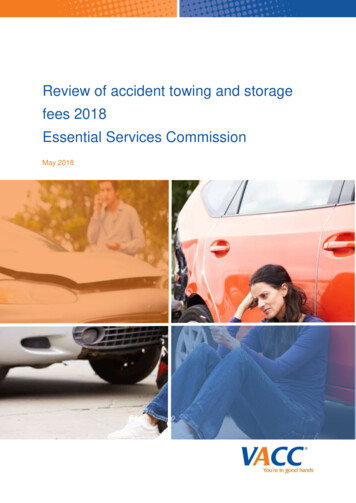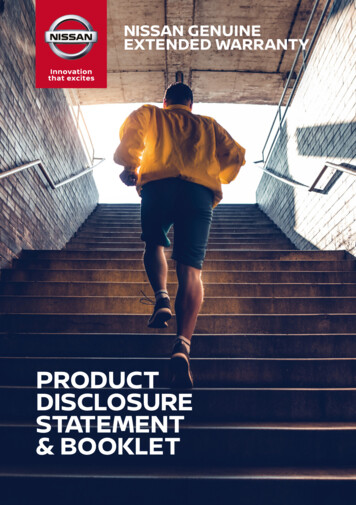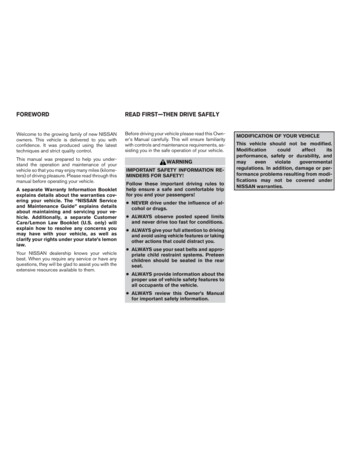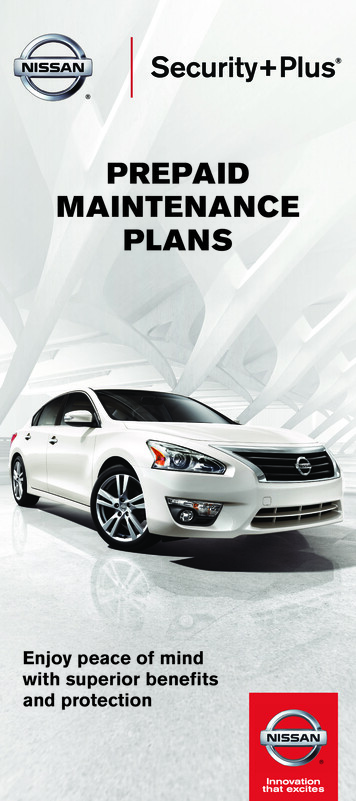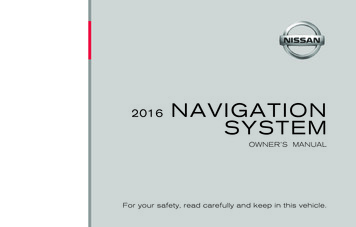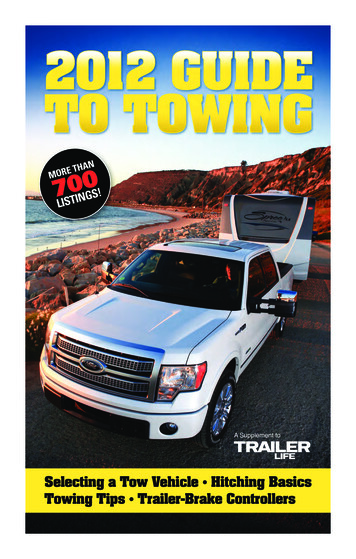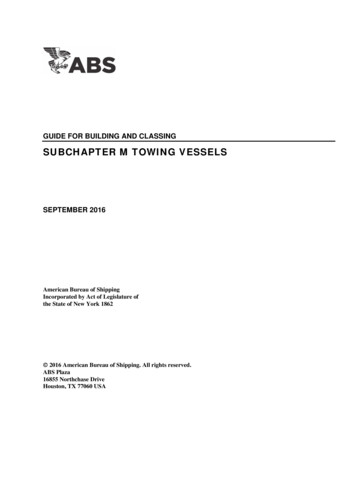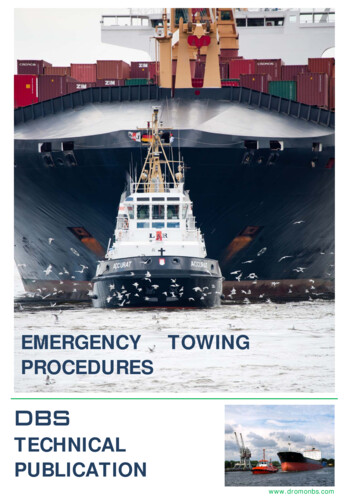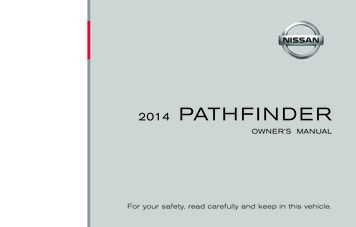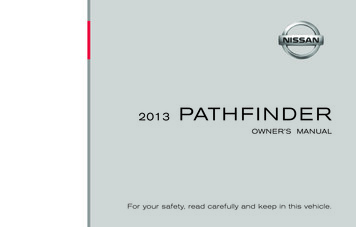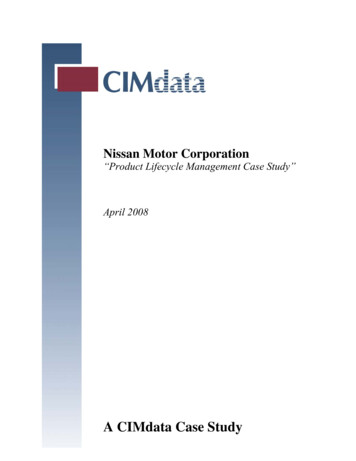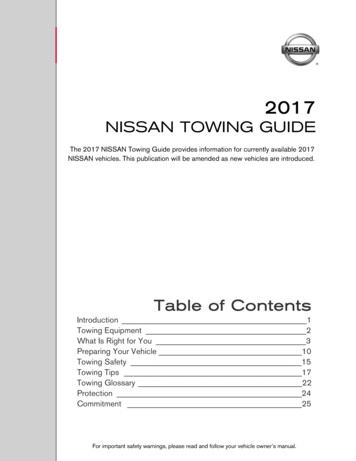
Transcription
92017NISSAN TOWING GUIDEThe 2017 NISSAN Towing Guide provides information for currently available 2017NISSAN vehicles. This publication will be amended as new vehicles are introduced.Table of ContentsIntroduction 1Towing Equipment 2What Is Right for You 3Preparing Your Vehicle 10Towing Safety 15Towing Tips 17Towing Glossary 22Protection 24Commitment 25For important safety warnings, please read and follow your vehicle owner’s manual.
INTRODUCTIONSAFETY IS PRIORITY ONEObviously, your first concern should be safety. Your vehicle was designed to be used primarilyto carry passengers and cargo. Always remember that towing a trailer places additional loadson your vehicle’s engine, drivetrain, suspension, and steering, braking, and other systems.Therefore, be certain that your vehicle can meet the demands of the towing application youhave in mind.Rent or purchase towing equipment that complies with established industry standards andstate and federal safety regulations. Reinforced tow hitches designed especially for certainNISSAN vehicles are available from your NISSAN dealer. Hitches for other NISSAN models –if Nissan recommends towing with that vehicle - should be bought from and installed by aprofessional supplier of towing equipment. Carefully review all information and literatureprovided with any hitch you purchase for safety and proper use information.Finally, it is important to follow the towing capacity limit set for your specific vehicle, and toensure that your vehicle is in top mechanical condition, especially the tires, brakes,suspension, and engine cooling system. See your vehicle owner’s manual for details.WHAT IS THE ESTABLISHED TOWING CAPACITY FOR YOUR VEHICLETowing capacities vary from vehicle to vehicle. See the towing information in your vehicleowner’s manual to confirm whether your NISSAN vehicle can be used to tow and if so, whatits towing capacity rating is. Use this data to help select the proper NISSAN vehicle to meetyour anticipated towing needs, and refer to it when renting a trailer or other piece of towingequipment.EQUIP YOUR NISSAN FOR TOWINGThe frequency and type of towing dictate the manner in which you equip your vehicle. If youplan to tow often, for either recreation or work, select the engine size, transmission type,suspension, and towing capacity that are best suited to your requirements. This guide canhelp you select that equipment.If, on the other hand, your towing will be infrequent, choose the NISSAN vehicle andequipment that best meets your day-to-day needs. Be careful not to exceed the towingcapacity on those few occasions when you do tow.READ THIS GUIDE BEFORE YOU TOWThis guide was designed to provide an overview of safe towing practices. Here, you will findinformation on towing equipment, safety, proper loading and driving techniques, towing tips,and much more.2017 NISSAN Towing Guide1
It is also a good idea to discuss your towing requirements with either your NISSAN dealer or aprofessional supplier of towing equipment before you equip your NISSAN vehicle for towing.Finally, there are state and local laws on towing that you should review to ensure compliancewith all regulations.CAUTION- Do not use your new vehicle to tow a trailer or haul a heavy load for thefirst 500 miles (800 km) of use. Your engine, axle or other parts could be damaged. Forthe first 500 miles that you tow a trailer, do not drive over 50 mph and do not make starts atfull throttle. This helps your engine and other parts of your vehicle wear in at heavier loads.TOWINGEQUIPMENTRENTINGThe first thing to keep in mind when renting any type of tow equipment, trailer, or tow dolly, isto rent only from professional companies that specialize in towing and towing equipment.More than likely, specialized companies hire professional staff that can assist you in selectingand installing the proper towing equipment for your NISSAN vehicle.When renting, make sure you have your vehicle owner’s manual on hand so that you canreference the towing capacities for your specific vehicle. Make certain that the tow equipmentand components you rent does not exceed your vehicles maximum towing capacity. Make surethat any related towing equipment you rent has the proper weight class rating for yourmaximum intended towed load weight; do not exceed the maximum Gross Combined WeightRating.While you are there, ask questions. How much does the empty trailer weigh? How muchweight will the trailer hold? What is the trailer’s tongue load? What type of brakes is itequipped with (if any)? All of these factors have an effect on whether your NISSAN vehicle iscapable of safely pulling that type of trailer, dolly, or tow equipment.Make certain that the trailer stoplights, taillights, turn signals, and brakes (if equipped) areconnected and operating correctly, and all safety equipment is properly installed. Check thesafety chains/cables, tie-downs, etc.For safer operation, carefully inspect the condition of the trailer and towing equipment.Specifically, check to make sure the tires are not worn excessively and are properly inflated.Make sure there are not any broken welds, missing bolts, and that the hitch components arenot damaged. Towing safety should be a high priority when choosing and renting towingequipment, including hitches.WARNING: NEVER RENT A CLAMP-ON-TYPE HITCH. The hitch should not beattached to or affect the operation of the impact-absorbing bumper. Use only a permanenttype hitch properly attached to the vehicle to help avoid personal injury or property damage.2017 NISSAN Towing Guide2
PURCHASINGIf you are buying a travel or boat trailer, be sure that your NISSAN vehicle has the towingcapacity to pull it. Refer to your vehicle owner’s manual for detailed information regarding thetowing capacity of your specific vehicle. Your vehicle owner’s manual should ALWAYS bereferenced before making any towing decisions.Naturally, you will want to select the towing and safety equipment that adheres to yourstates and federal safety regulations. Moreover, if you plan to tow often, considerconvenience. Quick-disconnect trailer light connectors and ratchet-type tie-downs, forexample, make the job go faster and easier and are usually worth the extra small investment.Purchase towing items such as hitches and hitch balls only from your NISSAN dealer or aprofessional supplier of towing equipment.If you are intending to use your vehicle to tow a trailer you already own, you must ensurethat your loaded trailer remains well within your vehicle's towing capacity as specified in thevehicle owner's manual. In addition, you should purchase the right type, style, and class* ofhitch and towing equipment to properly adapt the trailer to your vehicle.WHAT ISRIGHT FOR YOUTYPES OF EQUIPMENTTowing requires a variety of equipment, and, depending upon the application, there can beseveral types or styles of each piece of equipment. Working with your NISSAN dealer or aprofessional supplier of towing equipment, it should be relatively simple to determine theproper type of equipment for your specific vehicle given the intended application. This sectionexplains the most common pieces of towing equipment available.HITCHESWhichever type of hitch you use, it should be firmly bolted to your vehicle, and should be ofthe appropriate weight class for the trailer, tow dollies, or towing equipment you intend to tow.In addition, keep the following in mind:WARNING -Never modify the vehicle’s brake or exhaust systems or its bodystructure/frame when installing the hitch. Modifying the exhaust system structure on a vehiclecould result in improper vehicle operation not covered by the vehicle’s warranty. It may alsolead to carbon monoxide leaking into the passenger compartment. Altering the brake systemcan adversely affect vehicle handling, braking and performance and could increase thelikelihood of an accident or personal injury or death.* Refer to your owner’s manual for the equipment class information specific to your vehicle.2017 NISSAN Towing Guide3
Installing an aftermarket hitch may affect the rear crash performance of your vehicle.Changing the crash performance of a vehicle could lead to more severe vehicle damage,personal injury or death in a crash. Be sure that the hitch does not interfere in any way withthe vehicle’s impact-absorbing bumper. Never attach a hitch or towing device to the vehicle bumper. This may affect theoperation of the impact-absorbing bumper. Use only a permanent-type hitch properlyattached to the vehicle to help avoid personal injury or property damage. Regularly check to see that all hitch-mounting bolts are securely fastened to ensurethe hitch will not come loose, and remains properly attached to the vehicle to helpavoid property damage, personal injury or death.CAUTION -For receiver-type hitches using a ball mount, the ball mount should beremoved when not towing, or by protecting it with a special cover, this will help protect it fromdamage, and prevent rust from forming on it. If you install a hitch yourself, remember that it must be securely attached to the frame orunderbody, according to the manufacturer’s instructions. Never attach a hitch or towingdevice to the vehicle axle housing. This may damage the housing, wheel bearings,wheels, or tires.Hitch TypesBumper Hitch – This is a special reinforcedbumper designed to accommodate astandard trailer hitch ball. The light-dutybumper hitch must support the trailertongue weight all by itself. The maximumtowing capacity when using the GenuineNissan step bumper, as a ball mount hitch islimited to 3,500 lbs. and 350 lbs. tongueload. Choose a proper class ball mountbased on the trailer weight.Receiver Hitch – A receiver hitch is bolteddirectly to the vehicle structure for addedstrength and durability. NISSAN bolt-onreceiver hitches are designed for use withNISSAN vehicles, and include thenecessary reinforcements, with ampleclearance around bumpers, and framemembers, etc. These hitches allow for theremoval of the ball mount when not towing.2017 NISSAN Towing Guide4
Weight-Distributing Hitch System – Thistype of system uses a “load-leveling” or“equalizing” hitch. The weight-distributingfeature helps shift trailer tongue weight toall axles of the tow vehicle and all trailertires.For Armada, Frontier, Pathfinder, Titan,and Nissan NV vehicles, a weightdistributing hitch ball mount (Class IV) isrecommended if you plan to tow trailers with a maximum weight over 5,000 lbs. This ballmount includes a 2-5/16” hitch ball and is available through your NISSAN dealer.NOTE – A weight-distributing hitch system may affect the operation of trailer surge brakes. Ifyou are considering use of a weight-distributing hitch system with a surge brake-equippedtrailer, check with the surge brake, hitch, or trailer manufacturer to determine if and how thiscan be done. Follow the instructions provided by the equipment manufacturer for installingand using the weight-distributing hitch system.Clamp-On Bumper Hitch – This temporaryhitch clamps onto the bumper assembly.WARNING-DO NOT USE a clamp-onbumper hitch on any NISSAN vehiclebecause using it may result in the trailerseparating from the towing vehicle. If thetrailer separates from the vehicle, it couldcause a crash, resulting in property damageand personal injury, or death. Use of this typeof hitch can also damage the towing vehicle.2017 NISSAN Towing Guide5
5th Wheel or Gooseneck Hitch –A 5th wheel or gooseneck hitch mountsin the bed of a pick-up and is designed forheavy-duty applications. A gooseneck5th Wheel Hitchhitch is available from NISSAN for theTitan XD. At this time, the Titan XD is theonly NISSAN vehicle approved for 5thwheel and gooseneck trailer towing.Gooseneck HitchBALL MOUNTA ball mount (also known as a drawbar) isa bar that holds a hitch ball, which insertsinto a receiver-type hitch. Ball mounts comein a number of weight capacities (3,500 lbs.,5,000 lbs., etc.) and sizes (1-7/8”, 2”, etc.),and can be weight distributing or non-weightdistributing. Choose a proper class ballHitchBallmount based on the trailer weight.HITCH BALLA hitch ball is bolted through a ball mount orBallMounthitch hole in the tow vehicle’s rear bumper.The coupler on the trailer tongue attaches over the hitch ball. Like ball mounts, hitch balls areavailable in a number of weight capacities and sizes. Most hitch balls have the size stampedon the top of the ball. The required hitch ball size is stamped on most trailer couplers.Always make sure the hitch ball selected has the proper shank diameter and weight rating forthe ball mount as well as the coupler on your trailer. Using a 1-7/8” hitch ball in a 2” coupler,for example, could result in the trailer separating from the tow vehicle.The diameter of the hitch ball shank must be matched to the ball mount hole diameter. The2017 NISSAN Towing Guide6
shank should be no more than 1/16” smaller than the hole.To keep the hitch ball in top condition, a simple maintenance routine is recommended.Coating it with light grease will minimize wear of both the coupler and hitch ball. In addition,removing the hitch ball when not towing, or protecting it with a special cover will help preventrust from forming on it.TRAILER TONGUEThe tongue is the part of the trailer that extends forward to meet the tow vehicle, and it carriesthe coupler assembly. Knowledge of the trailer minimum and maximum tongue load(conventional trailers) and king pin load (5th wheel and gooseneck trailers) is critical as it canhave a significant effect on the handling and capacity of the tow vehicle. Refer to your vehicleowner’s manual to view the maximum conventional trailer tongue load listed for your vehicle.Trailer tongue weight is the amount of downward pressure exerted onto the hitch ball. Keepthe tongue load between 10-15% of the total trailer weight. DO NOT exceed the maximumtongue load specification. If the tongue weight is below the recommended amount, you mustmove some of the load forward or add weight to the front frame of the trailer.SAFETY CHAINS/CABLESAlways use suitable safety chains/cablesbetween the tow vehicle and the trailer. If thehitch should break or become disengagedwhile towing, these chains/cables will helpprovide an emergency connection betweenthe vehicle and the trailer.When installed properly the chains/cablesshould be crossed under the trailer tongue,and attached to the hitch or vehicle frame.Crossing the chains/cables under the tonguewill help prevent the tongue from hitting theground should the trailer becomedisconnected. Be sure to leave enough slackin the chains/cables to turn corners withoutbinding; however, note that excessive slackwill allow the chains/cables to drag on theground.OKNot OKWARNING- Do not use S-hooks for attaching the safety chains as they may become unhooked while towing. If the S-hook unhooks, the emergency chains/cables will becomedetached, so if the tow hitch breaks or becomes disengaged, it will allow the trailer tocompletely break away causing property damage and possibly personal injury or death.The use of S-hooks is illegal in many states.2017 NISSAN Towing Guide7
CAUTION- To avoid damage to the bumper and chains/cables when making a sharp turn,do not attach the chains/cables too close to the coupler. Consult your trailer manufacturer forthe proper location of the chain/cable attachment to the trailer.REAR VIEW MIRRORSWARNING- In many cases, a trailer can block your rear vision when you are using only thestandard NISSAN rear view and outside mirrors. Be careful when changing lanes or turning.Using only these mirrors could cause an accident as they were not designed for towing.Trailer tow mirrors specifically designed for trailer towing can be adjusted for better visibilitywhen your rearward vision is obstructed while towing a trailer. Trailer Tow Mirrors are availableas an accessory for certain Nissan vehicles. Before using these mirrors, make certain thatthey comply with state and local regulations. It is recommended you contact your NISSANdealer for details.BREAKAWAY SWITCHOn a trailer with electric brakes, a breakaway switch can automatically activate the trailerbrake system if the trailer becomes separated from the tow vehicle. Should the trailer becomedetached, a breakaway switch may help prevent the trailer from wandering into another lane.WARNING-A breakaway switch relies on the power of a trailer battery, so make sure tomaintain the battery’s charge. Never use the breakaway switch to “park” the trailer on agrade. The battery would eventually discharge and release the brake, allowing the trailer toroll, which may cause property damage, serious injury or death. Be sure to leave enoughslack in the tether on the breakaway switch to turn corners without binding. If you do not, theelectric trailer brakes will lock-up and not release. See your trailer manufacturer for properinstallation of a breakaway switch that is compatible with your trailer braking system.TRAILER LIGHTSTrailer lights should comply with all applicable federal, state, and local regulations, and shouldbe in proper working order at all times. A trailer’s taillights, stoplights, and turn signal lightsmust be wired into the tow vehicle’s electrical system.*Most trailers operate on a four-wire system in which the stoplights and turn signal lightsutilize the same wire. Most all NISSAN vehicles have separate wires for the stoplights and turnsignal lights, therefore a device called a “converter” is needed.** Specifically, a “powered* Vehicles equipped with LED taillights require that wiring be connected at a specific location. Forassistance in hooking up trailer lights, contact your NISSAN dealer or a professional supplier of towing equipment.** If the vehicle is factory equipped with a trailer wiring connector, then no convertor is necessary. If your trailer isequipped with a 4-pin connector, an adapter will be needed to connect the trailer lights to the vehicle. Vehiclesequipped with the optional trailer tow package can be equipped with a 7-pin trailer harness connector.2017 NISSAN Towing Guide8
converter” must be used to provide power for all trailer lighting. This type of convertercreates only minimal additional electrical demand (draw) on the vehicle lighting circuits, whichprovides protection for the vehicle’s sensitive electronics. Always check for correct operationof the taillights, stoplights, and turn signal lights every time you connect a trailer for towing.Never replace vehicle fuses with fuses of a higher amperage rating than the original.CAUTION – Improperly installed or poor quality trailer harness wiring may adversely affectyour vehicle’s electrical system. Use only a NISSAN approved wiring harness, or equivalent,and consult your dealer or a professional supplier of towing equipment to obtain the properequipment and to have it installed.BRAKESAs with hitches, several types of braking systems are available. Most states require a separatebraking system on trailers with a loaded weight above a specific amount, therefore you shouldcheck to ensure you comply with all regulations and laws. Have a professional supplier oftowing equipment demonstrate proper brake function testing.Never connect a trailer brake system directly to the vehicle brake system. Most statesrequire a separate braking system on trailers with a loaded weight of 1,500 lbs. (680 kg)or more.Surge Brakes – The surge brake actuator is mounted on the trailer tongue with a hydraulicline running to each trailer wheel equipped with disc brakes. Surge brakes are activated bythe trailer pushing against the hitch ball when the tow vehicle is braking. Hydraulic surgebrakes are common on rental trailers and some boat trailers. In this type of system, there is nohydraulic or electric connection for brake operation between the tow vehicle and the trailer.Electric Trailer Brakes – Electric braking systems are activated by an electronic signal sentfrom a trailer brake controller (special brake-sensing module). If electric trailer brakes are usedand the vehicle is not equipped with an integrated trailer brake controller, NISSANrecommends the installation of an aftermarket trailer brake controller. For adjustmentspecifications, refer to the manufacturer’s instructions of the brake controller being installed.For your convenience, Armada, Frontier, Pathfinder, Titan, and NV vehicles are pre-wired toaccommodate most popular electric trailer brake controllers. A wiring harness* is eitherincluded with your vehicle or available from your NISSAN dealer. This harness provideselectric trailer brake controller input and output connections to the vehicle wiring. See aprofessional supplier of towing equipment for electric trailer brake controller availability.* Contact a NISSAN dealer or a professional supplier of towing equipment for information on trailersequipped with electric brakes and for Genuine NISSAN jumper harness availability for your specific vehicle.2017 NISSAN Towing Guide9
CAUTION- The NISSAN trailer brake controller has been verified to be compatible withtrailers having electric actuated drum brakes (one to four axles) and electric- over-hydraulicbrakes. It will not activate hydraulic surge-style trailer drum brakes.SWAY CONTROL DEVICESudden maneuvers, wind gusts, and buffeting caused by other vehicles can affect trailerhandling. Sway control devices may be used to help control these effects. If you choose touse one, contact a reputable trailer hitch supplier to make sure the sway control device willwork with the vehicle, hitch, trailer and the trailer’s brake system.GENUINE NISSAN PARTS AND ACCESSORIESWhether you will be towing occasionally or on a regular basis, NISSAN offers a full range ofGenuine NISSAN Parts and Accessories to help you tow with confidence.Every Genuine NISSAN Parts and Accessory is thoroughly tested and inspected for fit andworkmanship. Therefore, you can be certain that every item is designed to be compatible withthe standard features of your vehicle and designed to assist you with your towing needs.It is recommended you contact your NISSAN dealer for more information on accessories ortowing-related parts for your NISSAN vehicle.PREPARINGYOUR VEHICLEBREAK-IN AND MAINTENANCE SCHEDULECAUTION- NISSAN recommends that you allow a sufficient “break-in” (500 miles) of boththe engine and drivetrain before towing with your new NISSAN vehicle. Do not tow a trailer orhaul a heavy load for the first 500 miles. For the first 500 miles that you tow a trailer, do notdrive over 50 mph and do not make starts at full throttle. This helps the engine and otherparts of your vehicle wear in at heavier loads.Keep in mind, too, that towing places higher demands and added loads on vehiclecomponents, so more frequent maintenance is called for. Your NISSAN Service &Maintenance Guide provides the accelerated maintenance schedule for towing purposes.Engine oil, filter, transmission fluid, and possibly other fluids should be changed morefrequently when towing.MEASURING VEHICLE WEIGHTThe key to safer, efficient towing has to do with weight. Your vehicle — SUV, crossover, truckor passenger car — is capable of carrying and towing only a certain amount of weight. Youmust compare your vehicle’s tow weight ratings with the combined weight of the vehicle,2017 NISSAN Towing Guide10
trailer, and their contents. This will help ensure that the total weight does not exceed any ofyour vehicle’s tow weight ratings.There are four weights to consider when towing: Gross Vehicle Weight Gross Axle Weight (Front and Rear) Gross Combined Weight Trailer Tongue/King Pin LoadThese ratings are based upon normal highway driving and may be reduced if operating inreduced-traction situations, (for example, slippery boat ramps).WARNING – Attempting to tow loads greater than the GVWR, GAWR, GCWR,overloading and/or improperly loading the trailer tongue/king pin load specified couldadversely affect vehicle handling, braking, and performance. This may result in unsafe vehiclehandling and longer braking distance, which could result in a serious accident and personalinjury. Failures to your vehicle caused by overloading are not covered by your vehicle’swarranty.GROSS VEHICLE WEIGHT (GVW)The Gross Vehicle Weight (GVW) is the actual weight of the fully loaded vehicle or trailer,including passengers, cargo, fuel, hitch, trailer tongue/king pin load, and any optionalequipment.The best way to determine the GVW is by having the vehicle — loaded and ready totow — weighed at a public scale. That figure must include the combined weight of allpassengers and cargo that are normally in the vehicle when towing a trailer.The GVW you come up with must not exceed the Gross Vehicle Weight Rating (GVWR)for your vehicle.2017 NISSAN Towing Guide11
F.M.V.S.S.Certification LabelOn all NISSAN vehicles, the GVWR is shown on theFederal Motor Vehicle Safety Standard (F.M.V.S.S.)certification label located in the driver’s-side door area.Weigh your vehicle on the scale with all of thepassengers and cargo that are normally in the vehiclewhen pulling a trailer. Subtract the actual vehicleweight from the GVWR. The remaining amount is theavailable maximum tongue/king pin load.To avoid overloading the vehicle, be sureMFD BY NISSAN MOTOR CO., LTDDATEGVWRGAWR FR.WITHRIMS ATTIRESPSIRIMS ATTIRESPSICOLD SINGLEGAWR RR.WITHCOLD SINGLETHIS VEHICLE CONFORMS TOALL APPLICABLE FEDERALMOTOR VEHICLE SAFETYSTANDARDS IN EFFECT ONTHE DATE OF MANUFACTURESHOWN ABOVE.SEE OWNERS MANUAL FORADDITIONAL INFORMATION.to include the trailer tongue/king pin load as apart of the cargo when determining how much weightcan be safely carried inside the vehicle.TYPE: TRUCKMODEL:COLORTRIMAXLE3B000TRANSENGINEGROSS AXLE WEIGHT (GAW)The Gross Axle Weight (GAW) is the maximum weight placed on a single axle (front and rear)that it is designed to safely carry.To determine the GAW, load the vehicle as you would for towing and attach the loadedtrailer. At a public scale, with the loaded trailer attached, place only the tow vehicle's frontwheels on the scale to determine the actual front axle GAW. To obtain the rear axle GAW,place all four tow vehicle's wheels on the scale. From that figure, subtract the front GAW andyou will have the rear GAW amount. The cargo in the trailer and the vehicle may have to bedistributed, or some removed to meet the specified rating.The GAW you come up with must not exceed the Gross Axle Weight Rating (GAWR)for your vehicle. On NISSAN vehicles, the GAWR for both axles is listed on the F.M.V.S.S.certification label.2017 NISSAN Towing Guide12
GROSS COMBINED WEIGHT (GCW)The Gross Combined Weight (GCW) is the total weight of the tow vehicle with allpassengers, cargo, and fuel, plus the total weight of the trailer and all its cargo.To determine the GCW, simply weigh your vehicle when fully loaded and ready to tow, andadd in the weight of the loaded trailer.The GCW you come up with must not exceed the Gross Combined Weight Rating(GCWR) for your vehicle. Refer to your vehicle owner’s manual to view the maximumGCWR specification listed for your vehicle.TRAILER TONGUE/KING PIN LOADThe amount of trailer’s weight pressing down on the tow vehicle hitch ball is called trailertongue load (conventional trailer) or king pin load (5th wheel and gooseneck trailers).To measure trailer tongue/king pin load, place the tongue of the trailer on a scale when thetrailer is not attached to thevehicle. A separate vehiclejack — not the trailer jack —should be used, as thelocation of the trailer jack isrearward of the trailer tongueand will not give you anaccurate measurement of thetrue tongue/king pin load.Make sure the vehicle jack isplaced directly under thetrailer tongue coupler, and the tongue is set at the height/level of the tow vehicle hitch.For proper handling, you must keep conventional trailer tongue load between 10-15% ofthe actual trailer weight, within the limits of the maximum trailer tongue load allowable.2017 NISSAN Towing Guide13
For example, to determine the proper trailer tongue load for a 1,500-lb. trailer, multiply theweight of 1,500 lbs. by 10% to arrive at a figure of 150 lbs. 5th wheel and gooseneck trailerking pin load must be kept between 15-25% of the actual trailer weight, within the limits ofthe king pin load allowable.Some trailer types may require different trailer tongue loads for safe towing. Always followthe trailer manufacturer’s recommendations for proper trailer set-up and trailer tongue load.Keep the trailer tongue load within the maximum trailer tongue load allowable. Additionally,make sure the vehicle has the payload capacity available for the trailer tongue load.Refer to your vehicle owner’s manual to view the maximum conventional trailer tongue loadlisted for your vehicle.WARNING – DO NOT exceed any of the individual vehicle weight ratings (GVWR,GAWR, GCWR, etc.), regardless of trailer or hitch type. Overloading or improper loading of atrailer can cause unsafe vehicle handling, braking and performance and may lead to a seriousaccident and personal injury or death.HITCH & TRAILER HEIGHTIt is important that your trailer floor and tongue ride as level as possible. This will help preventover-angling, bottoming-out, and improper tongue load and load transfer. Therefore, the hitchor trailer tongue must be adjusted during the initial vehicle/trailer fit-up to ensure a level ride.Ball mounts are available in different configurations to adjust the hitch ball height.TIRE PRESSUREWhen towing a trailer, ensure that the t
its towing capacity rating is. Use this data to help select the proper NISSAN vehicle to meet your anticipated towing needs, and refer to it when renting a trailer or other piece of towing equipment. EQUIP YOUR NISSAN FOR TOWING The frequency and type of towing dictate the manner in which you equip your vehicle. If you
